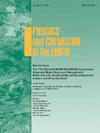A data-driven approach to arsenic classification in groundwater in geothermal Systems: Meta-Analysis and machine learning applications in Western Anatolia, Turkiye
IF 4.1
3区 地球科学
Q2 GEOSCIENCES, MULTIDISCIPLINARY
引用次数: 0
Abstract
Western Anatolia, Türkiye, is renowned for its diverse geothermal resources, encompassing high, medium, and low enthalpy systems. While these systems are valuable for energy production and economic development, they are also associated with significant environmental challenges, particularly high concentration arsenic and boron contamination. This study highlights critical hotspots, including Sandıklı (27 mg/L) and Banaz-Hamamboğazı (95.64 mg/L), with arsenic levels far exceeding the World Health Organization's (WHO) maximum permissible limit of 10 ppb. Such contamination poses significant risks to water quality, agriculture, and public health, especially in major agricultural provinces like Aydın and Manisa. To address these challenges, machine learning models were applied to classify arsenic concentrations. Ensemble methods, including AdaBoost (ABC) and Extra Trees (ETC) classifiers, consistently outperformed others, showing high accuracy of about 97 % in distinguishing geochemical signatures and predicting arsenic levels. In contrast, the k-Nearest Neighbors Classifier (KNNC) proved less effective, with frequent misclassifications. The combination of machine learning and meta-analysis provided a robust framework for identifying spatial and temporal patterns of contamination, offering valuable insights for environmental monitoring. This approach not only enhanced the understanding of arsenic distribution in geothermal systems but also provided actionable insights for mitigating contamination risks. The findings underscore the importance of combining computational techniques with environmental geochemistry to improve the management of geothermal wastewater. Future research should expand these methodologies to other regions and contaminants, leveraging machine learning to develop more effective environmental protection strategies. This study demonstrates the potential of data-driven approaches to address critical environmental issues and supports sustainable development in geothermal-rich areas.
地热系统中地下水砷分类的数据驱动方法:在土耳其安纳托利亚西部的元分析和机器学习应用
西部安纳托利亚,trkiye,以其多样化的地热资源而闻名,包括高焓、中焓和低焓系统。虽然这些系统对能源生产和经济发展很有价值,但它们也带来了重大的环境挑战,特别是高浓度的砷和硼污染。这项研究突出了关键热点,包括Sandıklı(27毫克/升)和Banaz-Hamamboğazı(95.64毫克/升),砷含量远远超过世界卫生组织(世卫组织)的最大允许限值10 ppb。这种污染对水质、农业和公众健康构成重大威胁,特别是在Aydın和马尼萨等主要农业省份。为了解决这些挑战,应用机器学习模型对砷浓度进行分类。包括AdaBoost (ABC)和Extra Trees (ETC)分类器在内的集合方法一直优于其他方法,在区分地球化学特征和预测砷水平方面显示出高达97%的准确率。相比之下,k近邻分类器(KNNC)被证明不太有效,经常出现错误分类。机器学习和元分析的结合为识别污染的时空模式提供了一个强大的框架,为环境监测提供了有价值的见解。该方法不仅提高了对地热系统中砷分布的认识,而且为减轻污染风险提供了可行的见解。这些发现强调了将计算技术与环境地球化学相结合以改善地热废水管理的重要性。未来的研究应该将这些方法扩展到其他地区和污染物,利用机器学习来制定更有效的环境保护策略。这项研究展示了数据驱动方法在解决关键环境问题和支持地热资源丰富地区可持续发展方面的潜力。
本文章由计算机程序翻译,如有差异,请以英文原文为准。
求助全文
约1分钟内获得全文
求助全文
来源期刊

Physics and Chemistry of the Earth
地学-地球科学综合
CiteScore
5.40
自引率
2.70%
发文量
176
审稿时长
31.6 weeks
期刊介绍:
Physics and Chemistry of the Earth is an international interdisciplinary journal for the rapid publication of collections of refereed communications in separate thematic issues, either stemming from scientific meetings, or, especially compiled for the occasion. There is no restriction on the length of articles published in the journal. Physics and Chemistry of the Earth incorporates the separate Parts A, B and C which existed until the end of 2001.
Please note: the Editors are unable to consider submissions that are not invited or linked to a thematic issue. Please do not submit unsolicited papers.
The journal covers the following subject areas:
-Solid Earth and Geodesy:
(geology, geochemistry, tectonophysics, seismology, volcanology, palaeomagnetism and rock magnetism, electromagnetism and potential fields, marine and environmental geosciences as well as geodesy).
-Hydrology, Oceans and Atmosphere:
(hydrology and water resources research, engineering and management, oceanography and oceanic chemistry, shelf, sea, lake and river sciences, meteorology and atmospheric sciences incl. chemistry as well as climatology and glaciology).
-Solar-Terrestrial and Planetary Science:
(solar, heliospheric and solar-planetary sciences, geology, geophysics and atmospheric sciences of planets, satellites and small bodies as well as cosmochemistry and exobiology).
 求助内容:
求助内容: 应助结果提醒方式:
应助结果提醒方式:


